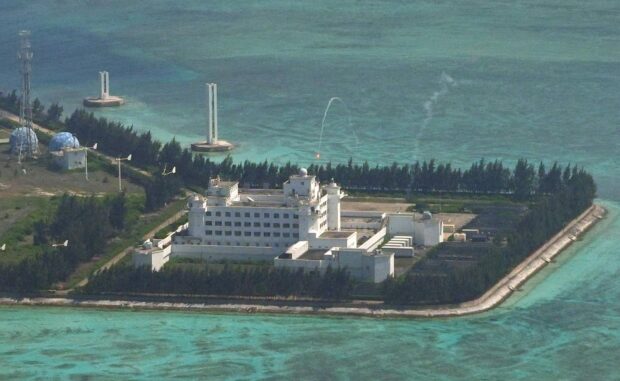
A completely developed island fortress. Chinese authorities send a flare warning to the plane carrying the professional civilian photographer, telling them they are flying over Chinese territory. CONTRIBUTED PHOTOS
MANILA, Philippines—A stark reversal from how it was when Rodrigo Duterte was still in Malacañang, the way the current administration is dealing with China’s aggression in the West Philippine Sea is now considered an expression of commitment that “we are not backing down.”
But should the conflict escalate into war, how will the Philippines defend itself?
Last March, a professional civilian photographer was on board a small plane but as they went closer to an island built by China on the West Philippine Sea, Chinese authorities launched a flare as warning and declared an intrusion into Chinese territory.
According to international relations and defense analyst Joshua Bernard Espeña, a resident fellow of the think tank International Development and Security Cooperation (IDSC), this move by China was “two-pronged.”
He said one, China’s hostile action of firing a flare to chase away Filipinos inside Philippine exclusive economic zone (EEZ) “is nothing new for an ambitious regional power like China.” China, said Espeña, “is keen on repudiating international law.”
“This fact has been China’s behavior since the 2010s,” he said.
But Espeña, a lecturer at the Polytechnic University of the Philippines, told INQUIRER.net via email that “the fact that it (China) remains unmoved remains bothersome on the Filipino and American allies’ end.”
“To complement both aspects, it sends this message: ‘Philippines, what you do with your American ally will not weaken or alter China’s position in the South China Sea, [including the] West Philippine Sea,” Espeña said.
RELATED STORY: More than 100 Chinese maritime militia vessels, warship still in West Philippine Sea — PCG
According to Dr. Chester Cabalza, in an interview by FB Messenger, President Ferdinand “Bongbong”Marcos Jr.’s “western side” is evident. “He understands the American way more than the Chinese,” said Cabalza.
Cabalza, a security expert, said “as a direct result, Beijing would always be on guard of the Philippines’ actions,” saying that Marcos’ statement affirming strong defense ties with the United States was a sign that the relationship between the two countries was becoming “warm and stronger.”
As Marcos visited the US, he said the Philippines is looking at the world power as its “sole treaty partner” in strengthening and redefining ties amid tensions in the South China Sea and the Asia Pacific.
READ: PH looks to ‘sole treaty partner’ US to strengthen ties – Marcos
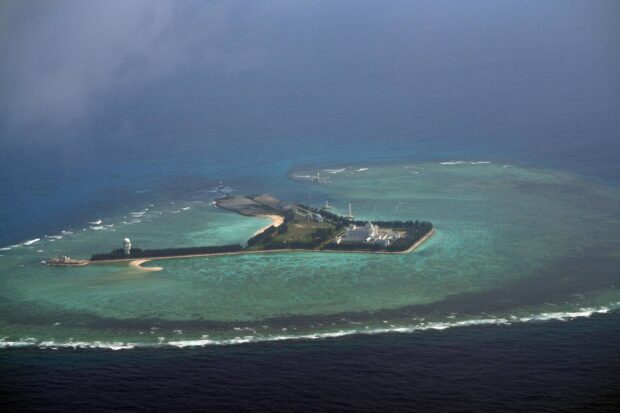
CONTRIBUTED PHOTO
Since last year, as Marcos took office, Filipinos have seen a tougher government stand against China’s aggression, which persisted and grew despite the Permanent Court of Arbitration’s (PCA) decision declaring Beijing’s nine-dash line claim to nearly the entire South China Sea, including West Philippine Sea, as at best fictitious and without legal basis.
One of the tactics being employed to counter China’s aggression was “tell all” which the Philippine Coast Guard (PCG) said had been approved by the National Task Force for the West Philippine Sea. Commodore Jay Tarriela had expressed hope the tactic would work.
Last week, a China Coast Guard (CCG) vessel cut off BRP Malapascua, one of PCG’s patrol vessels, causing a near crash off Spratly Islands—the latest in a string of unarmed confrontations between the Philippines and China.
READ: Chinese, Philippine vessels in ‘David and Goliath’ near-crash
Rodel Hernandez, the PCG vessel’s commanding officer, said the BRP Malapascua and the BRP Malabrigo had broadcast their intention to sail to the area to conduct a “site survey” and asked CCG vessels to “stay clear from our passage.”
But the CCG responded that the PCG vessels, which were likewise carrying journalists, were illegally sailing within China’s waters, and told them to leave. As Hernandez said, “we would have collided on the bow had I not cut the engine and thrown it in reverse.”
Dr. Elaine Tolentino, an international relations analyst, said in an interview through FB Messenger that “the PCG should continue with its strategy of meeting the CCG head on to signal China that we are not backing down.”
READ: China says Philippine boat’s ‘provocative action’ caused near-crash
Cabalza, president and founder of the think tank IDSC, said it was in 2013 when China flexed more of its military muscle as the Philippines filed a case at the PCA.
Through the years, however, the United States made its presence more visible in the region with US officials visiting Taiwan and Philippine officials agreeing to expand US access to more military bases.
Cabalza said the US’ “marked visibility” made China feel “threatened and contained.”
As foreign affairs and security expert Lucio Pitlo III said also via FB Messenger, China was “likely to step up pressure” in the West Philippine Sea to show opposition to the Philippine decision granting expanded US access to more military bases and joint patrol plans in the South China Sea.
Last month, Malacañang, through the Presidential Communications Office, identified the additional locations for the Enhanced Defense Cooperation Agreement between the Philippines and the US: Camilo Osias Naval Base in Sta. Ana town, Lal-lo Airport in Lal-lo town, both in Cagayan province, Camp Melchor dela Cruz in Gamu, Isabela, and Balabac, Palawan.
While the Department of National Defense said these “are seen to boost disaster response,” the new locations would bring American soldiers nearer to two flashpoints—Taiwan and West Philippine Sea.
With China’s aggression, Tolentino said the US-Philippines alliance and the Philippines’ relations with the other regional powers become crucial at this time since “we simply cannot outmatch China’s military capacity.”
“The worst scenario is an outright Chinese military attack or invasion, and the Philippines’ current military capacity is too miniscule compared to China,” said Tolentino. “We continue to rely on our partners as we strengthen our military,” she said.
According to the 2023 Asia Power Index by the Australian Lowy Institute (ALI), the Philippines, with a score of 12.8 out of 100, improved two places, ranking 16th out of a list of 26 countries in terms of power based on resources.
RELATED STORY: Chinese militia vessels in WPS show Beijing’s endless blatant disregard of PH EEZ
Released this year, ALI said the US retained top spot with a score of 80.7, while China trailed with a score 72.5. Next were Japan (37.2), India (36.3), Russia (31.6), Australia (30.9), South Korea (29.5), and Singapore (25.1).
The Philippines’ strongest measure is defense networks, where it placed ninth, “reflecting the extent of its bilateral military cooperation with treaty ally US.” Its weakest measure is resilience, where it ranked 20th, in part as a result of internal conflicts.
“Over the past year, its military capability has risen by two places to 17th,” said ALI, a think tank based in Australia.
“The Philippines exerts more influence in the region than expected given its available resources, as indicated by the country’s positive power gap score,” ALI said.
Cabalza explained that in case of invasion, the Armed Forces of the Philippines (AFP) “has a military niche in urban warfare due to their recent experience on the Marawi siege.” He was referring to the war waged by AFP against Islamic State (IS) terrorists who launched a campaign to overrun Marawi, the Philippines’ only Muslim city where IS planned to establish a caliphate.
The AFP’s exposure to China’s gray zone strategy in the West Philippine Sea is also part of the strengths that the Philippine Navy and Philippine Marine Corps can nurture, said Cabalza, a University of the Philippines professor.
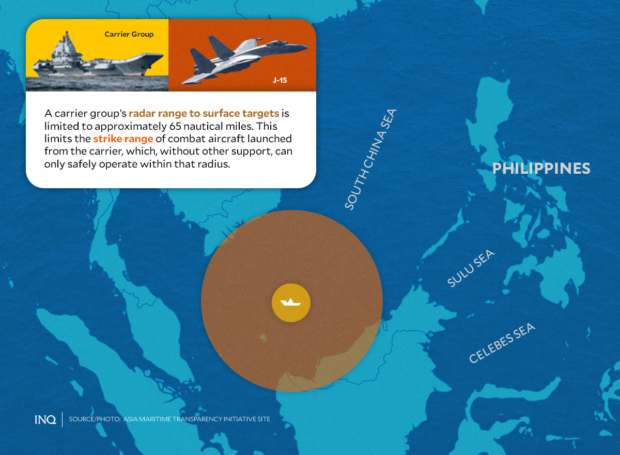
GRAPHIC: Ed Lustan based on Asia Maritime Transparency Initiative
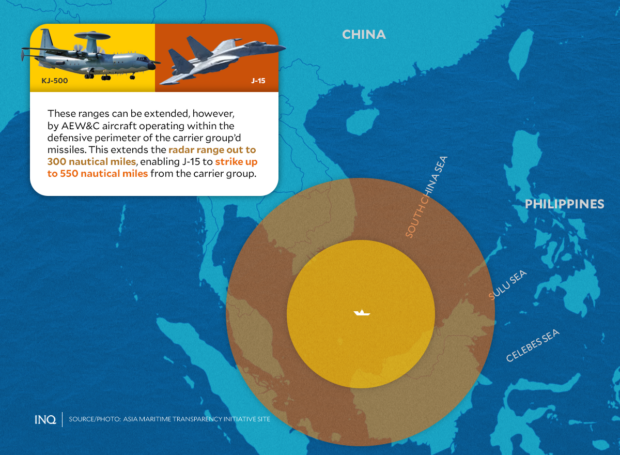
GRAPHIC: Ed Lustan based on Asia Maritime Transparency Initiative
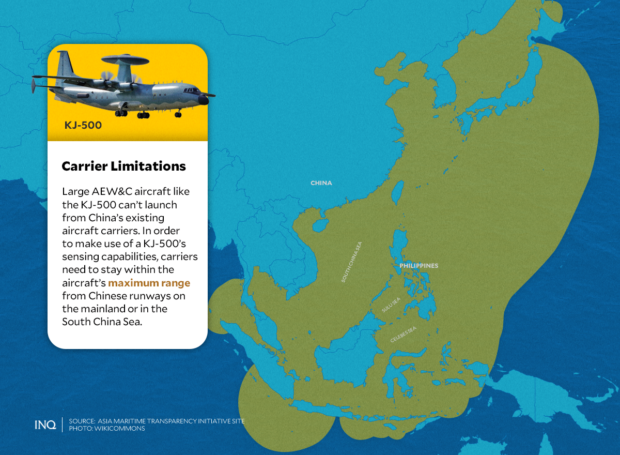
GRAPHIC: Ed Lustan based on Asia Maritime Transparency Initiative
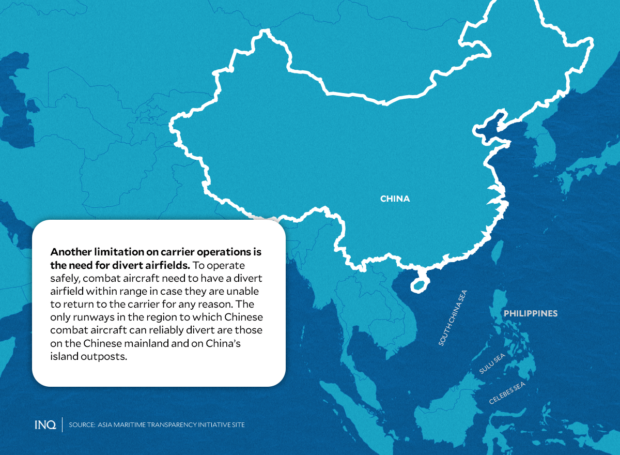
GRAPHIC: Ed Lustan based on Asia Maritime Transparency Initiative
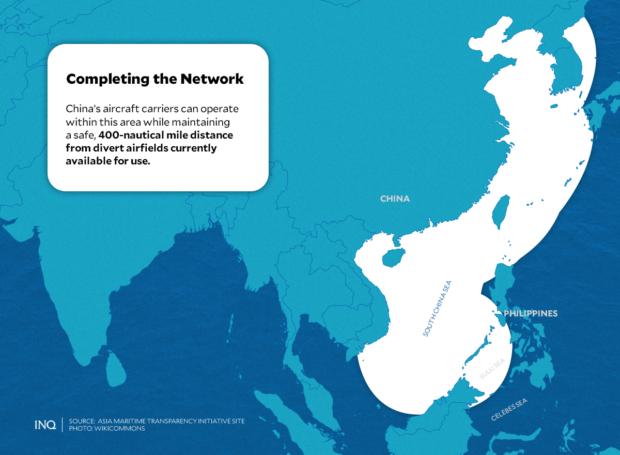
GRAPHIC: Ed Lustan based on Asia Maritime Transparency Initiative
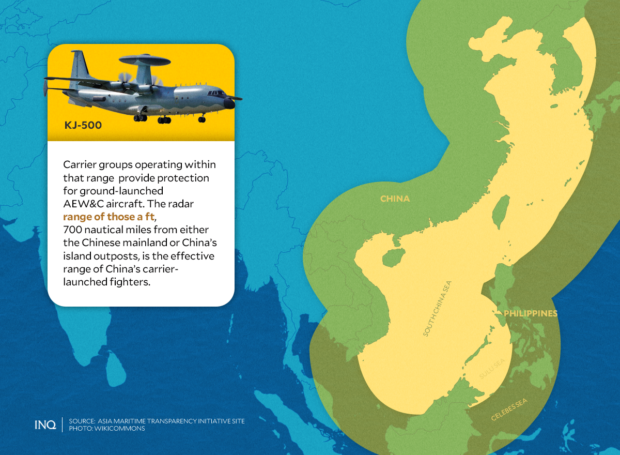
GRAPHIC: Ed Lustan based on Asia Maritime Transparency Initiative
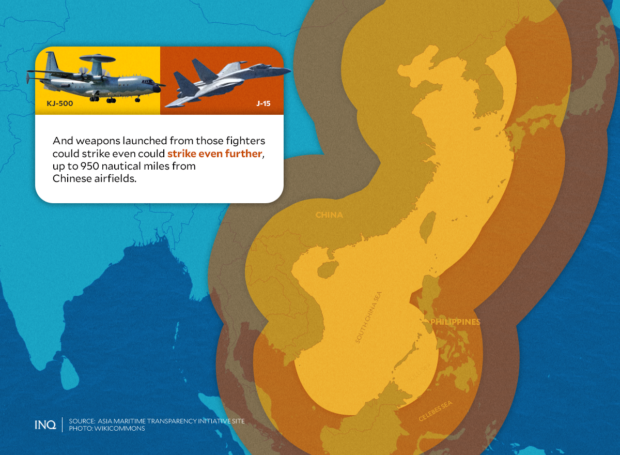
GRAPHIC: Ed Lustan based on Asia Maritime Transparency Initiative
Espeña described the Philippines’ defense capabilities as “meager yet willing,” saying that the Philippines acquires more “eyes and ears” with US help.
The AFP is certainly no match for China’s People’s Liberation Army in terms of military might. But willingness to work in an alliance with the US is one of the Philippines’ strengths, said Espeña.
“As the Balikatan 2023 shows, the AFP-US Armed Forces (USAF) is improving interoperability, making it harder for China to kick the Philippines out of the game as it would escalate things,” Espeña said.
This year’s Balikatan, which started on April 11 and concluded on April 28, involved 17,767 troops—12,187 Americans, 5,469 Filipinos and 111 Australian “observers.”
READ: ‘Balikatan’ an ‘incredible’ success, says US envoy
But should China’s aggression escalate into an armed conflict, Cabalza said “we can hold off given the experience of the military on local insurgency and terrorism.” He said that the Philippines has been fighting a communist insurgency for more than five decades now.
“Manila also has a world war experience with the US,” he said, referring to the Philippine-US alliance during World War II.
“This will enable allies of the Philippines to enable us to defend our territory. The recent Balikatan exercises show that the Philippines is naval-ready now as it shifts from internal security to external defense,” Cabalza said.
In terms of how long it would take the US to come to the Philippines’ aid in case of an attack by China, Espeña said without the Enhanced Defense Cooperation Agreement (Edca) help from the US military stationed in Guam would take about three days to scramble and 15 days for US forces based in Hawaii.
“With the Edca in place, however, we can expect a 12 to 24-hour response,” he said.
However, much can happen within a day, and in all honesty, the Philippines will not be able to hold it off alone, which explains the commitment between AFP and USAF to keep a high level of readiness, response and resilience in a multi-domain warfare scenario.
“Again, meager but willing,” Espeña said.
Tolentino said a military invasion by China poses great risks for itself and would work like a double-edged sword—“it could further augment Chinese nationalism. If it fails, it could backfire against the CCP (Chinese Communist Party) and cause domestic instability.”
She said that the South China Sea and West Philippine Sea maritime territories are different since these are not fully occupied. “Taiwan is also a different case since China considers it a domestic issue although an invasion would also pose a great risk to China, which it simply cannot afford,” Tolentino said.
“For the Philippines, a strong interoperability with allied powers can help us weaken China,” said Cabalza.
“Manila’s recent urban warfare in Marawi and gray zone skirmishes in the West Philippine Sea are strengths that could be used,” he said.
“Most importantly Filipinos should be prepared for any eventuality,” he added.
According to Tolentino, a DLSU associate professor, “the current Biden administration looks more committed than previous administrations to provide assistance.” In a worst case scenario, this would be key to the US defending the Philippines in a military confrontation with China, she said.
The US, last weekend, expressed commitment to stand with the Philippines amid the People’s Republic of China (PRC) Coast Guard’s “continued infringement upon freedom of navigation in the South China Sea.”
China should “desist from its provocative and unsafe conduct,” said the US State Department in a statement following the near collision of Philippine and Chinese vessels in Philippine EEZ.
“Imagery and video recently published in the media is a stark reminder of PRC harassment and intimidation of Philippine vessels as they undertake routine patrols within EEZ,” said the US State Department statement.
“The United States continues to track and monitor these interactions closely,” it said.
As explained by Cabalza, there are three possibilities for the Philippines to counter China’s aggression.
First, he said the role of diplomacy is important to deter China from continuing aggression and plausible invasion of the Philippines, especially since diplomacy is construed as a first line of defense.
“Our Filipino diplomats should be skillful enough on how to tame China and not to further antagonize it.”
According to Pitlo, “we have much to learn from how our ASEAN neighbors Vietnam, Malaysia and Indonesia handle their maritime spat with China while expanding economic ties with our big northern neighbor.”
Like in the Philippines, South China Sea is a major security challenge for other ASEAN countries, but they have refrained from making it front and center of ties with China: “It begs the question of whether our current strategy is the most appropriate.”
“Far from ‘naming and shaming,’ being noisy and openly vocal about exposing Chinese activities in disputed waters, they have adopted discreet and off-the-screen approaches in managing the row arguably with better success than us,” said Pitlo.
The second option, Tolentino said, is the “tell all strategy” of the PCG and ongoing modernization of the military which could serve as deterrence.

Pag-asa Island. CONTRIBUTED PHOTO
Cabalza said collective deterrence shown in the Philippine alliance with the US and like-minded nations is recommended to balance China’s military might.
For Cabalza, “well-thought doctrines and effective strategy are important for interoperability that certainly affect the morale of our soldiers and coast guardians to prepare for any eventuality.”
“Winning any war does not entail quantitative military assets but a strong leadership and consistent national narrative that would protect our people and sovereignty,” he said.
This, as he stressed that diplomacy and negotiations do matter in an anarchic regional system particularly when the Philippines is trapped in the rivalry of two superpowers in the region.
He said that the Philippines has risen now into a middle power because of its strength on multilateral diplomatic engagements and adherence to global rules-based norms.
“Reversing the tide of conflict depends on the skillful acts of our leader, top diplomats, and commanding generals to avoid any miscalculation in our tense region,” said Cabalza.
Espeña said with Edca in place, “we now have resolved the ‘ambiguity riddle’ of the 1951 Mutual Defense Treaty.”
Although this is but a means to an end, he said.
“The best way to win at the grand strategic level is to communicate to China the impossibility of achieving its objective of occupying the First Island Chain unchallenged either by the US or regional states like the Philippines,” said Espeña.
He said communication, in this sense, requires a concerted diplomatic, military, informational, and economic statecraft.
Militarily, the alliance must be resilient in all war-fighting domains, given the scenario in Ukraine: Wars are not necessarily short due to belligerents at the table.
This resilience of hard power could also build soft power and attract international community support with the Philippines fighting a good cause, Espeña said.
“Informationally, the Philippines must continually leverage the 2016 Arbitral Ruling as a moral force in public diplomacy and produce raw footage of its possible crimes of aggression, crimes against humanity, and war crimes,” he said.
“Diplomatically, the Philippines must use its middle power status to call out China at the international, regional, and bilateral levels to support the Philippines,” Espeña said.
RELATED STORY: Carpio offers Duterte no-war options to enforce arbitral ruling